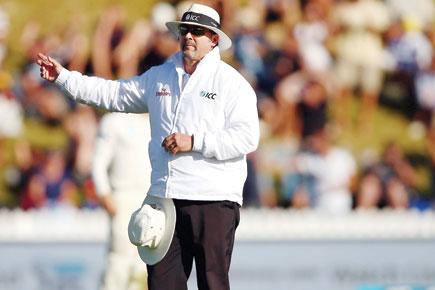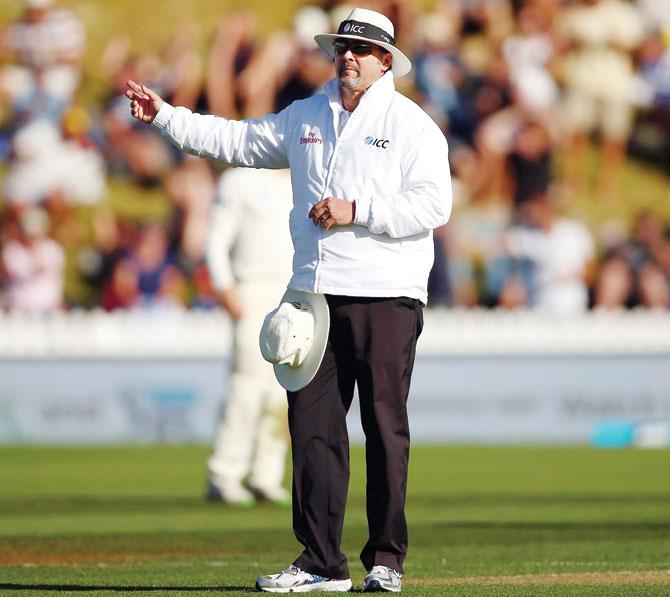A simple return to the back-foot no-ball law will eradicate the existing confusion and inconsistency, writes Ian Chappell

Umpire Richard Illingworth signals a no-ball after Australia's Adam Voges was clean bowled by New Zealand pacer Doug Bracewell at the Basin Reserve in Wellington last week
 No one should be surprised that the front-foot no-ball law is creating controversy and confusion and that umpire Richard Illingworth's error gave Adam Voges a monumental reprieve in the Wellington Test.
No one should be surprised that the front-foot no-ball law is creating controversy and confusion and that umpire Richard Illingworth's error gave Adam Voges a monumental reprieve in the Wellington Test.
In 1962, Richie Benaud asked Sir Donald Bradman (both favoured a back-foot law) to act as an umpire in the nets to prove how the then, new front-foot no-ball law was unworkable. When the photographs taken in that experiment were developed, Benaud found; “An umpire, on more occasions than not, would be calling no-ball when in fact the ball was perfectly legitimate, by something like half an inch. It was just that the umpire's line of sight was pushing the bowler's boot forward so it looked as though it was a no-ball.”
ADVERTISEMENT

Umpire Richard Illingworth signals a no-ball after Australia's Adam Voges was clean bowled by New Zealand pacer Doug Bracewell at the Basin Reserve in Wellington last week. Pic/Getty Images
Illingworth's error
Knowing that, it's no surprise Illingworth incorrectly called Doug Bracewell's delivery that bowled Voges a no-ball. What's less clear is why a batsman is reprieved by video replay of a no-ball but a bowler isn't entitled to similar privileges.
The answer we're told is the poor old batsman might alter his shot on hearing the umpire's call of “No-ball.”
What planet are these officials from? If a bowler — even one operating at 150 to 160 kph — over-steps by mere millimetres (the general infringement) it makes absolutely no difference at the batsman's end. And secondly, under the front-foot no-ball law a batsman facing a fast bowler doesn't have time to change his mind let alone his shot by the time the umpire's call registers.
Over the years, all sorts of weird and not-so-wonderful changes to the law have been proposed, including placing a third umpire on the field to adjudicate solely on the front-foot. I wonder what excuse would be proffered when this umpire inevitably got in a tangle with a fielder during either an attempted catch or run out?
A simple return to a back-foot no-ball law, which was only abandoned because of draggers, would not only eradicate the confusion and inconsistency but also bring other positives to the game.
A back-foot no-ball law would virtually eradicate the infringement and make over-rates less of a blight on the game. By having the standing umpire concentrate on the bowler's back rather than front foot, he would have longer to focus on the batsman's end of the pitch. This should improve umpiring standards, especially when fast bowlers are operating.
How do you overcome the sole objection to this change; the possibility it would resurrect draggers with their front foot landing way beyond the batting crease?
If the umpire placed a disc where he wants the bowler to land his back foot so that he's not encroaching on the batsman's territory, that should ensure fair play allround.
How does the umpire know where to place the disc for each bowler?
Simple. There's footage of every international bowler taken from side-on via run out cameras, so by viewing this footage, a mark is established for all bowlers. This is one way technology can be used to improve the game and bowlers' marks could be reviewed often.
Two complaints
There are two constant complaints about this system.
1) It's arbitrary.
No more so than the front-foot no-ball law where bowlers of differing heights land their back foot in vastly different positions. This would be the same under the proposed law but the umpire has more time to adjudicate by watching the back rather than the front foot.
2) Umpires prefer laws that are black and white.
What can be more muddled than the current situation where replays of two different deliveries, striking exactly the same spot on a stump, show one is out and the other is not out lbw, because of the decision made by the on-field umpire? The black and white excuse is pure obfuscation.
As I often hear; “The problem with commonsense is, it's not that common.” That saying is applicable to many of the current laws and it's time the flaws were seriously addressed.
 Subscribe today by clicking the link and stay updated with the latest news!" Click here!
Subscribe today by clicking the link and stay updated with the latest news!" Click here!







